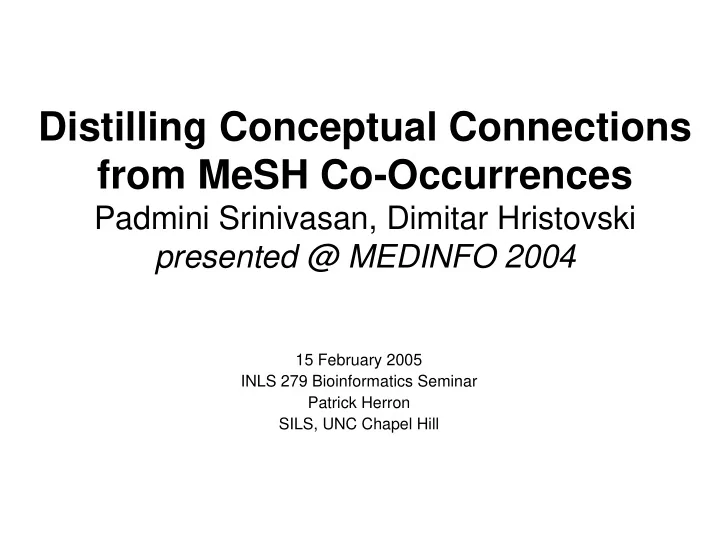

Distilling Conceptual Connections from MeSH Co-Occurrences Padmini Srinivasan, Dimitar Hristovski presented @ MEDINFO 2004 15 February 2005 INLS 279 Bioinformatics Seminar Patrick Herron SILS, UNC Chapel Hill
Goals • Analyze MeSH heading/subheading pair co-occurrences, e.g., ( diabetes / drug therapy ) with ( chemical / therapeutic use ) heading/concept subheading heading/concept subheading • Interestingness : Select semantically meaningful ones (via chi-sq) that are relatively domain independent • Develop a “reasonable representation” of each pair: “a weighted vector […] [emphasizing] verb based functional aspects of the underlying semantics” • The ultimate goal: such pairs may aid in generating connections across disciplines across all of MEDLINE
Reducing the problem space: using the SN • In order to reduce scale of the problem space… 20,742 concepts * 82 headings=1.7 mil heading/subheading pairs, 1.7mil 2 /2 (number of possible heading subheading pairs) = 1.5 trillion • and in order to be as domain-independent as possible… • Represent concepts by their semantic types in the SN • 20,742 -> 134 (semantic type/subheading) • Problem space down to (134*82) 2 /2 = 60 mil (two orders of magnitude smaller) • Only 1 mil of that 60 mil is meaningful
Method • Usual approaches vs. Srinivasan et al • Extraction of [(st/sh) i , (st/sh) j ] pairs • Selection of background dataset • Analysis of a single pair
Usual approaches • First hand-pick relevant verbs & then extract their arguments • Set of 1 mil co-occurrences too big for manual approach • We want to extract interesting verbs based on MeSH co-occurrence
Srinivasan et al approach • Two step approach: 1. automatically identify/extract key verbs associated with a [(st/sh) i , (st/sh) j ] pair 2. Use these verbs to extract highly related Ns and NPs • This paper establishes one method for step 1; work on step 2 is for a later date • We want a weighted verb vector for MeSH co-occurrences
Extraction of [(st/sh) i , (st/sh) j ] pairs • Corpus: MEDLINE to 2001 into rows with MEDLINE record id (MRI), Head/subhead • Transformed into MRI, Sem Type/subhead • Then [(st/sh) i , (st/sh) j ] pairings picked & frequencies noted • 30% 1x, 97% < 500 over 11 million records • Pairings further culled by two more criteria: 1. freq > 500) down to 31,000 pairs & 2. (observed co-occurrence >= 1.25*expected co-occurrence) lowered total to 22,000 pairs • 250 randomly selected; documents were reliably retrieved for 228 of those
Co-occurrence calculations • Actual co-occurrence of pair A,B (# docs w/ A * # docs w/B) / (total number of documents) 2 • Expected co-occurrence of pair A,B (# docs w/ A * # docs w/B) / total number of documents (Expected – observed)/expected * 100 > 0.25 •
Selection of background dataset • 100,000 MEDLINE records randomly selected • Title + abstract POS-tagged • Verbs extracted & used as vector to represent doc; verbs transformed to infinitives • IDF for each verb as log 2 (100,000/df) • BV: background vector: set of (verb, IDF) pairs for each record – our doc vector D???
Analysis of a single pair • Identify all docs in which pair appears • 2/3 rds of docs placed in training set • Other 1/3 rd plus random 1/3 rd from MEDLINE in test set • Create verb profile for pair • Test verb profiles
Creating verb profile • Docs POS-tagged & Vs extracted • Rules for inclusion: V must occur in at least 5 docs; V frequency in training set must be significantly different from its freq in BV – using Pearson’s test (null hypothesis: difference between expected and observed frequencies is random) • Formation of the profile vector, to which weights are assigned just like with the BV, BUT..
Formation of the profile vector • Four different profile vectors are formed: – V,AugTF – V,AugTF*IDF – V,TF*IDF – V,IDF • Empirical question as to how each performs
Testing profiles • Test each of the 4 PVs against the doc vectors D of the random set and that 1/3 rd of documents in which pairs occur • Similarity of a background vector to a PV as dot product of two vectors (D, PV) • Mean similarity (D, PV) of random set & mean similarity of topic set calculated • Variance/information/interestingness: significant difference in similarities for a pair indicates interestingness
Results: Verb profiles • Example of top five Pair Verbs verbs from the [(disease or syndrome, Withdraw, warrant, drug) & (lipid, adverse undertake, treat, AugTFIDF PV effect)] tolerate • Authors claim these verb profiles will provide useful constraints for extracting pair-associated nouns
Results: test set
Results: evaluation • Each bar represents one of the 228 pairs plus standard error • If a line touches the diagonal then the similarity is possibly random • All pairs show significant similarity • “in the right direction”
Conclusions • Verbs are important • Verb profiles from docs with MeSH co- occurrence pairs are different from docs not covered by pair: verb profiles can be used to characterize other docs w/ co- occurrenc
Questions • How did Srinivasan et al decide only 1 mil of the 60 mil possible [(st/sh), (st/sh)] pairings are meaningful? Chi sq test with null hypothesis that pairings are random? • What is the meaning of those similarity values? How significant??? • Once we have noun-verb representations of MeSH co-occurrences, what does that get us? • What’s truly interesting about MeSH co- occurrence? Connecting otherwise disparate pieces of the literature
Recommend
More recommend